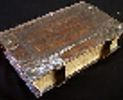
Martyr, Syracuse
At the beginning of the 4th century, the Roman Empire was facing a crisis, and the authorities attempted to recall the empire to the traditional Roman standards, customs and religion, with the consequent rejection of such recent innovations as Christianity. Systematic persecution of the church began in 303. Among those killed was Lucy of Syracuse in Sicily. We have no other reliable information about her. Her cult became widespread at an early date, and her name was added to commemorations in the eucharist in several rites. Many churches were dedicated in her name.
A traditional account of her life describes her as a Sicilian aristocratic virgin who refused offers of marriage, engaged in works of charity and was betrayed to the authorities by an irate suitor. Paschasius, the Governor of Syracuse ordered her to burn a sacrifice to the emperor's image. When she refused Paschasius sentenced her to be defiled in a brothel. The Christian tradition states that when the guards came to take her away, they could not move her even when they hitched her to a team of oxen. Bundles of wood were then heaped about her and set on fire, but would not burn. She was eventually despatched with a sword thrust through her throat. Centuries later stories were added about her eyes being plucked out and then miraculously restored, and because her name is derived from the Latin word for light, Lucy came to be associated with sight and light.
Her feast once coincided with the Winter Solstice, the shortest day of the year, before calendar reforms, so her feastday has become a festival of light, in Scandinavian countries, with their long dark winters. There, a young girl dressed in a white dress and a red sash (as the symbol of martyrdom) carries palms and wears a crown or wreath of candles on her head. In both Norway and Sweden, girls dressed as Lucy carry rolls and cookies in procession as songs are sung. It is said that to vividly celebrate St. Lucy's Day will help one live the long winter days with enough light.
BORN: 283 AD,
Syracuse, Sicily,
Roman Empire
DIED: 304 AD,
Syracuse, Sicily,
Roman Empire.

 Welcome
Welcome Calendar
Calendar Today's Word
Today's Word Lauds
Lauds Terce
Terce Sext
Sext None
None Vespers
Vespers Compline
Compline Matins
Matins